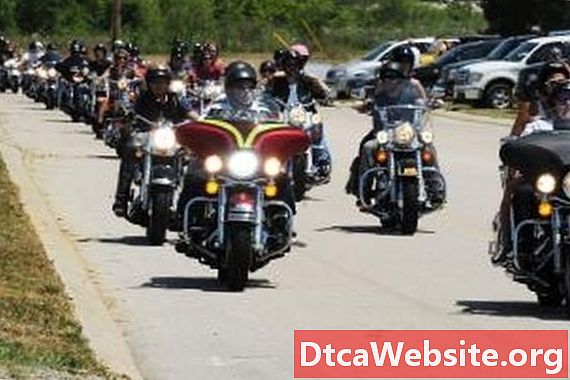
Contenu

The Harley-Davidson FLH model has had three major incarnations, the Hydra-Glide, Duo-Glide and Electra-Glide. Harley-Davidson identifies its motorcycles with a specific model name and each belongs to one of five model families; Sportser, Dyna, Softail, VRSC (V-twin, racing, street, custom), and Touring. Harley also manufactures trikes and offers custom models of various bikes under the CVO (Custom Vehicle Operations) banner. Each model also has a multi-letter designation. Generally, the first (and sometimes second) letter designates the engine type and sometimes the frame or front end, as in the FL model, introduced in 1941.
The Hydra-Glide
In 1949, Harley added its first hydraulic front forks to the FL model and dubbed it the FLH or Hydra-Glide. The Hydra-Glide maintained the big V-twin engine that Harley had introduced in 1948, the Panhead, which replaced the Knucklehead. The 1949 Hydra-Glide engine was 1,200 cc with a 7-to-1 compression ratio and reportedly put out 50 horsepower at 4,800 rpm and gave the bike a top speed of 100 mph. Until 1952, the FLH Hydra-Glide was equipped with a foot clutch and hand shifter. Refinements to the Panhead engine in 1953 increased compression to 8-to-1, horsepower to 60 at 4,800 rpm and top speed to 105 mph. Elvis Presley owned a 1957 FLH, the last year that the model was called the Hydra-Glide.
The Duo-Glide
The next big change to the Harley-Davidson FLH was the addition of rear brakes and hydraulic rear suspension, in 1958. Harley renamed the new model the Duo-Glide, though it maintained the FLH model designation. The Duo-Glide also featured a sprung seat, making it even more comfortable, and suitable for touring. The rear suspension on the Duo-Glide had three adjustment settings: solo, heavy, and tandem.
The Electra-Glide
In 1965, Harley-Davidson replaced the kick starter on the FLH with an electric starter and renamed the model the Electra-Glide, again keeping the FLH identifier. The electric starter necessitated a larger, 12-volt battery and modifications to the frame to accommodate the bigger battery. The 1965 FLH had a compression ratio of 8-to-1, 60 horsepower at 5,400 rpm and a top speed of 100 mph. To increase the range of the big-twin tourer, the Electra-Glide also had a 5-gallon "Turnpike" fuel tank. CNBC names the 1965 Electra-Glide as one of the most notable Harleys ever, and puts the estimated value of one of the approximately 6,900 original models at $30,000, as of 2011. Harley-Davidson replaced the Panhead engine with the Shovelhead on all Electra-Glide models beginning in 1966.
Electra-Glide Variations
Harley-Davidson continues to manufacture variations of the Electra-Glide. In 1969, Harley added the iconic fork-mounted "batwing" fairing. The FLH got a power increase in 1978 when the Shovelhead was bumped up to 1300 cc. The FLHR Road King burst onto the scene in 1994. Still technically considered an Electra-Glide, the Road King has spawned a number of variations of its own. For the 2011 model year, Harley-Davidson listed six distinct FLH model variations on its website; the Electra-Glide Classic, Ultra Classic Electra-Glide, Electra-Glide Ultra Limited, Road King, Road King Classic, and the Street Glide.


